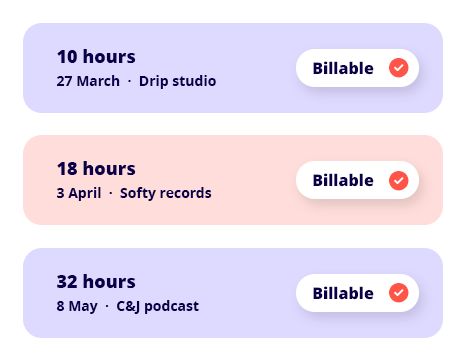Track time & create timesheets for your team
Track time and manage employee timesheets with our easy-to-use time tracking software!

Time tracking software with all the features you need
Easy to use employee timesheets that makes work hours tracking a breeze
Invite your staff to access your Reckon One book under the employee system role. This time tracking solution provides them their own login to create timesheets. From there it’s quick and easy for your employees to create their own employee time tracking entries including sick leave, ready for you to approve. It’s time tracking made easy!

Approve timesheet submissions with a click
When your employees finalise their online timesheet they submit them for approval. From there you can approve or decline them with the click of a button, ensuring all employee timesheets are accurate. You can also add a decline reason so your employee knows why, allowing them to correct their timesheet and resubmit it for approval.

Create pay runs from your timesheet entries
With one checkbox you can pull in your timesheet data to create a pay run*. Once timesheet data has been imported into a pay run, it can be updated and edited like normal including editing individual employees or adding employees without timesheet data. A massive time saver for busy business owners!
*Requires payroll. Add payroll software from an extra $12/mth >

Assign billable time to clients
Your employees can also mark their timesheets as billable and assign them to a client*. From there, when you create an invoice for that customer, a little pop-up display prompts you to add this billable time to their invoice. Great for agencies, freelancers, tradies and those working in project management!
*Requires invoicing.

Plans that fit your business needs and your pocket
30-DAY FREE TRIAL + SAVE 50% FOR 6 MONTHS ON ALL PLANS.
Payroll Essentials
For businesses with up to 4 employees
$6/ month
Was $12
Save $36 over 6 months
Up to 4 employees**
Process pay runs
Email payslips
Manage Single Touch Payroll
Calculate superannuation
Track leave & entitlements
Payroll reporting
Payroll companion app
Employee facing app
Track timesheets
Employee expense claims
Free data migration††
Free onboarding session
Advanced reporting
Payroll Plus
For businesses with up to 10 employees
$12.50 / month
Was $25
Save $72 over 6 months
Up to 10 employees**
Process pay runs
Email payslips
Manage Single Touch Payroll
Calculate superannuation
Track leave & entitlements
Payroll reporting
Payroll companion app
Employee facing app
Track timesheets
Employee expense claims
Free data migration††
Free onboarding session
Advanced reporting
Payroll Premium
For larger businesses
$25/ month
Was $50
Save $150 over 6 months
Unlimited employees**
Process pay runs
Email payslips
Manage Single Touch Payroll
Calculate superannuation
Track leave & entitlements
Payroll reporting
Payroll companion app
Employee facing app
Track timesheets
Employee expense claims
Free data migration††
Free onboarding session
Advanced reporting
† Transactions that exceed the 1000 limit will be subject to the BankData Fair Use Policy.
†† Free data migration offer includes 1 year of historical data + YDT only. Paid subscriptions only.
Helping thousands of businesses with their payroll
Frequently asked questions
How does the 30-day free trial work?
The Reckon One free trial allows you to try our accounting software for a period of 30 days to ensure it meets the needs of your business. After this period, your subscription will automatically convert to a paid one to avoid any interruptions to your data. However, if you find that Reckon One small business accounting software is not suitable for your needs, you can cancel your subscription before the billing renewal date and your credit card won't be charged.
If life got in the way and you weren’t able to use your trial, no worries! Just give our friendly support team a shout and we’ll see if we can get you up and running again.
How do I switch from another software to Reckon One?
Making the switch to Reckon One is a breeze with our data migration service! Here’s how it works:
- Fill out our data migration form.
- Sit back and relax while we handle the migration process.
- In just 3 to 5 business days, we’ll reach out to you to review your migrated data.
- Once you’re happy with your migrated information, we’ll transfer ownership of your files to you.
You can find more information here.
What do I need to get set up with Reckon One?
There is no software installation required. All you need is a device with an internet connection to access your Reckon One account. Simply sign up for an account on our website and start using Reckon One to manage your business.
Is my data secure?
We use the best technology to ensure your data is safe and secure. Reckon One, is built with cutting-edge HTML5 technology and hosted on Australian servers powered by Amazon Web Services, a leader in cloud data storage.
Can I change my software plan later on?
Definitely! Reckon One offers you the flexibility to change your plan to fit the unique needs of your business. Whether it’s downgrading or upgrading, you can easily make these changes right from your Reckon account.
Do you provide customer support?
We offer support through email, chat, and phone with our local team and resources such as webinars, a small business resource hub, and an online community to help you succeed from the moment you start using Reckon One.
Expert training is also available through the Reckon Training Academy or our trusted partners (accountants and bookkeepers).
Can I grant access to other people?
Is there a minimum subscription period?
Enjoy the benefits of Reckon One with the flexibility of monthly payments and if you decide it's not the right fit for your business, you can easily cancel at any time.
Try our time tracking software for your whole team today, for free!
Cancel anytime.



